|
[Front Page] [Features] [Departments] [SGAP Home Page] [Subscribe]

Gardening for butterflies
....some basic principles and a Townsville case study
Peter Valentine
Introduction
The idea of gardening for butterflies is not particularly new as naturalists have for centuries been fascinated by this colourful group of insects and the relationships they have with plants. However, in recent years a plethora of publications have emerged which have both encouraged and guided people in converting their gardens into friendly places for butterflies. In both the USA and Britain numerous publications appeared in the 1970s and 1980s which reported on butterfly gardening and they included articles in both insect related journals and plant journals (eg Brewer, 1979; Collman, 1983; Cribb, 1982). Some writers recognised the potential butterfly conservation significance of gardens (eg Owen, 1976).
Much of the information available was drawn together in some useful books published in the USA including Tekulsky (1985), Schneck (1990) and Stokes et al. (1991). The Xerces Society also brought together a great deal of expertise to provide a book on butterfly gardening (1990). In Britain the Linnaean Society has developed a program called "FLORA-for-FAUNA" which encourages the use of native plantings to support native wildlife. Australians have also been increasingly interested in butterfly gardening and this is reflected in publications including the pioneering guide from Tablelands Branch of SGAP (Sankowsky, 1982). Other examples include Clyne (1990), Hay et al. (1994) and Coupar & Coupar (1992). Increasingly, plant guides are including sections on species suitable for attracting birds and butterflies (eg Townsend, 1994). There has also been a number of publications which identify the presence and significance of butterflies in urban landscapes (e.g. Valentine 1993, 1994, 1995). For many parts of Australia there is now good information available and an excellent opportunity to create butterfly gardens with significant prospect of success.
The most recent developments in this field include the emergence of numerous internet sites which deal extensively with butterfly gardening. Most of these, like the publications, are USA based but they give examples which may encourage Australians and indicate the potential for further work in Australia. Amongst the most useful starting points is the Butterfly Website which has links to many other opportunities and is currently running a strong promotion on butterfly gardening (http://butterflywebsite.com/). There is also a journal for butterfly gardeners called The Butterfly Gardeners Quarterly. Most of the electronic sites are USA or UK based and there is certainly an excellent opportunity for Australian native plant growers and butterfly enthusiasts to join forces for some more Australian sites. .
The remainder of this paper will outline the basic requirements of a butterfly garden and give examples of backyard butterfly gardening in Townsville. While the location leads to the possibility of many species of butterflies being attracted to a local garden in Townsville, some care and planning will considerably enhance the actual population of butterflies present.
The Australian Butterfly Fauna
There are 403 described species of butterflies in Australia. The number of species found at any particular location varies considerably. Other parts of Australia have many fewer species of butterflies than Townsville. For example Tasmania has only 39 species (too cold) while South Australia has only 64 (too dry). The preference for tropical conditions is shown by the presence of over 225 species on Cape York Peninsula alone and over 300 species in tropical Australia. It is believed that there are very few undescribed species of butterflies in Australia but every now and then one is discovered.
The Australian butterfly fauna may be divided into several families as shown in Table I which also indicates the key characteristics of each Family.
Table 1 - Main Characteristics of Different Butterfly Families
| Family | Features |
|---|
Hesperiidae
SKIPPERS | Mainly small, dull, primitive, fast, orange, brown, black, larvae construct shelters, subject to ant predation. |
Papilionidae
SWALLOW-TAILS | Large, colourful, flight strong or fluttering, larvae exposed, subject to ant predation. |
Pieridae
WHITES AND YELLOWS | Medium size, white or yellow, some colourful red and yellow and black; many larvae gregarious, some mistletoe feeders, migrants, ant prey. |
Nymphalidae
BROWNS, NYMPHS AND MILKWEED | Browns mainly small, medium and temperate; nymphs large and colourful, tropical; milkweed medium large mainly black & white, tropical. Subject to ant predation. |
Lycaenidae
BLUES AND COPPERS | Mainly small, blue or copper, underside often colourful, fast flying, larvae often with ants. |
 |
 |
Cephrenes augiades (Hesperiidae)
Orange Palm-dart
|
Toxidia doubledayi (Hesperiidae)
Lilac Grass-skipper
|
 |
 |
Graphium macleayanus (Papilionidae)
Macleay's Swallowtail
|
Papilio aegeus (Papilionidae)
Orchard Swallowtail
|
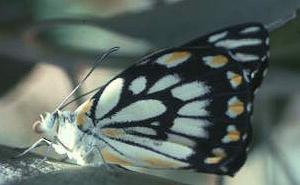 |
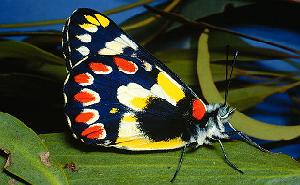 |
Belenois java (Pieridae)
Caper White
|
Delias aganippe (Pieridae)
Red-spotted Jezebel
|
| Butterfly images courtesy Museum of Victoria |
Townsville people are particularly fortunate when it comes to butterfly species richness. Within 100 km of the Townsville Post Office there are close to 50% of the 403 named Australian species. Even within the city proper, 144 species are known to occur. While all families are present in Townsville, the large papilionids (Birdwings, Swallowtails etc) are extremely well represented. Table 2 compares the butterfly species known from Townsville with the total known butterfly species within Australia.
Table 2 - Australian Butterfly Species in the Townsville Region
Species richness in Townsville compared with the Australian continent
| Family | No.
Species Australia | No.
Species Townsville | % Townsville | No.
Species Townsville+ | % Townsville+ |
|---|
| Hesperiidae | 120 | 33 | 27% | 51 | 42% |
| Papilionidae | 17 | 14 | 82% | 14 | 82% |
| Pieridae | 35 | 23 | 65% | 23 | 65% |
| Nymphalidae | 85 | 29 | 33% | 36 | 42% |
| Lycaenidae | 146 | 45 | 30% | 69 | 47% |
| Totals | 403+ | 144 | 35% | 193 | 48% |
Townsville = Townsville urban areas
Townsville + refers to greater region including Paluma, Bluewater, Mt Elliot - <100 km. |
 |
 |
Danaus plexippus (Nymphalidae)
Monach
|
Vanessa kershawi (Nymphalidae)
Australian Painted Lady
|
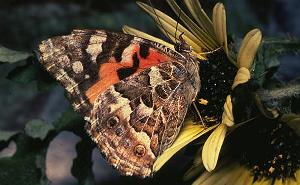 |
 |
Vanessa kershawi (Nymphalidae)
Australian Painted Lady
|
Hypochrysops ignita (Lycaenidae)
Fiery Jewel
|
 |
 |
Ogyris amaryllis (Lycaenidae)
Satin Azure
|
Zizina labradus (Lycaenidae)
Common Grass-blue
|
| Butterfly images courtesy Museum of Victoria |
One question which might be asked relates to the actual number of species to be expected in a garden. Although there are few accounts of butterflies of urban areas in Australia a good example is included in the Brisbane Wildlife Survey (Davies 1983). Using data provided by RL Kitching, the report listed species found in three suburban gardens between April 1980 and October 1981. The total number of species reported was 95 with a Mt Coot-tha garden recording 90 species. In an earlier review of Townsville urban butterflies, a single small garden was recorded as having 85 species positively identified over a number of years (Valentine, 1993). During a brief survey in March this year there were 50 species recorded on a residential property in Kelso during a two hour period. Of course all these figures relate to species richness. Abundance data are less well known. These figures are likely to vary enormously throughout the year with a post wet season peak.
The Garden Environment
Gardens can be managed to produce attractive environmental settings for butterflies although what may be needed will vary from place to place. Ideal conditions for most species involve warmth, sunshine, moisture, shelter from wind and rain and a suitable supply of larval and adult food sources. If the garden is too shaded, adults will not be attracted as most prefer sunny conditions to fly. Butterflies will also seek shelter from wind by perching in the lea of shrubs or trees, especially if this is also the sunny side. In hot dry periods some surface water is often attractive, especially small mud puddles where mineralised water may be imbibed. The males of many species prefer to perch at vantage points on the branches of trees, places which may be defended against intrusion by other males and from which females may be readily sighted. Females are unlikely to remain in an area if there are no suitable nectar sources or no plants which provide larval food. In some cases the constant attention from resident males causes females to abandon sites. Quite a few Australian species are migratory and in many cases it is easy to overlook the arrival of a female passing through. The first sign that a species has visited a garden may be the discovery of eggs or larvae on a food plant. Some first principles for the garden environment include ensuring much of the area is sunny for several hours each day; careful planting to exclude strong winds while retaining sunshine; numerous nectar sources from plants; the remainder of the area planted with plants used by butterfly larvae - ideally in several distinct clumps separated by sunny patches.
Attracting Adults
For most species of butterflies, adults seek nectar as a means of extending their lives. A few species never feed after emerging from the pupal form and these relatively short-lived species survive on accumulated energy from the larval stage. Many species also imbibe mineralised water from stream banks or mud puddles. Others seek bird or animal droppings as a specialised source of nutrients. Some species are attracted to rotting fruit including several tropical butterflies.
In almost all parts of Australia planting flowering shrubs and herbs is very useful. There are not many native species which provide ideal nectar sources for gardeners to concentrate butterflies in their gardens but Micromelum minutum is one. Seasonally useful plants include Bursaria spp, Leptospermum spp, Melaleuca spp, Callistemon spp and also Parsonsia spp. Most gardeners will find it useful to include some non-native plants for nectar. In cooler areas Buddleia davidii is useful while Pentas spp provides year-round nectar in the tropics. Some varieties of Lantana camara in cultivation may also be useful. The wild Lantana camara shrubs frequently attract adults. Many herbs and even weed species may also be valuable as nectar sources for adults. For species such as the Evening Brown (Melanitis leda) and the Orange Bush-brown (Mycalesis terminus), the provision of rotting fruit will bring the adults around; (in the tropics rotting treefall fruits of mango or carambola are particularly appealing, as are bananas).
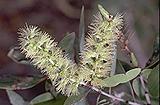 |
Melaleucas and callistemons are useful butterfly plants. This is the normal green-flowered form of Melaleuca viridiflora.
Select the thumbnail image or plant name for a higher resolution image (30k). Photo: Keith Townsend
|
 |
Bursaria incana has sweetly scented flowers. Bursarias, generally, are attractive to butterflies.
Select the thumbnail image or plant name for a higher resolution image (40k). Photo: Keith Townsend
|
Larval Requirements
The most important plantings to sustain a more or less permanent population of butterflies in a garden are the sources of larval food. In general, most Australian butterflies have larvae which feed on plants (exceptions include a few carnivorous species which feed on ant larvae). Most species feed on leaves but a few eat flowers and some eat fruit or seeds. Closely related butterflies usually feed on similar plants (from the same family or families). Most butterflies lay eggs singly but others lay in batches and their larvae are gregarious. In the wild females will spend their days searching for the correct species of plant and after laying on one plant will continue searching for new plants. A garden should provide more than one specimen, separated widely, to enhance the prospects of female oviposition. If catering for a wide range of species this will produce an interesting mix of species ranging in form from grasses, herbs, shrubs, trees, vines, epiphytes and hemi-parasites (mistletoes).
One complicating factor for butterflies in the family Lycaenidae (blues and coppers) is the frequent requirement for a symbiotic partner in the form of a particular species of ant. This may be quite difficult for gardeners to provide and usually the greatest success comes from identifying local ants already present and working with any of these which may have a mutualistic relationship with a local butterfly species. There is little point in preparing a garden setting for butterfly species which are not known from the area or at least nearby.
Here in Townsville a common mutualistic relationship occurs between a Crematogaster sp ant and the Copper Jewel butterfly (Hypochrysops apelles). If a colony of ants occurs in a garden then Copper Jewels may be attracted by providing appropriate plants in association with the ant colony; in this case planting a Cocky Apple tree (Planchonia careya) near the nest. If there are green ants in the garden, then planting Terminalia sericocarpa trees will soon result in both ant-infested trees and a colony of Oak-blue butterflies (maybe three species). These ant-plant-butterfly relationships add a great deal of interest and challenge to the gardener's task.
 |
Fiery Jewel butterflies (see above) are attracted to the flowers of Planchonia careya.
Select the thumbnail image or plant name for a higher resolution image (28k). Photo: Keith Townsend
|
Threats to Manage
One important fact to remember is that adult butterflies frequently lay between 300 and 500 eggs. In most cases very few of these survive to adulthood. What happens to the rest? Mortality begins immediately after the eggs are laid, in the first instance through parasitic wasps which lay their own eggs inside the butterfly egg. Or perhaps by ants carrying away the eggs to feed their own young. For those larvae which successfully hatch from the egg the world is a dangerous place. Small spiders love freshly hatched butterfly larvae. Young shield bugs or assassin bugs will be lining up to suck larvae dry from the time they are one or two mm long. The ever-present ants, especially green ants, will be busy carting off larvae of all size to feed their young.
Parasitic flies will dart the larvae with white eggs to soon produce fly larvae which burrow into the butterfly caterpillar and eat out the inside. These flies (Tachinidae) usually leave the larva to pupate. Other parasitic wasps (Braconidae) keep the butterfly caterpillar alive and exit the body through the underside where they pupate in little white cocoons (up to twenty or so) shielded by the remains of the larva. Much larger wasps (Ichneumonidae) insert a single egg into the prepupal stage, the female wasp sometimes riding around on the back of the final instar caterpillar waiting for it to commence pupation. These mature inside the pupa and finally emerge through the wall of the butterfly pupa. In some species viral and bacterial infection may be a major cause of death, in Birdwings for example viral infection frequently occurs when population density of larvae on the Aristolochia tagala food plant vines is very high. Apart from the insect predators and parasites there are many other threats to the juvenile stages of butterflies including birds and frogs. Despite an impressive array of defensive strategies including smells, hairs, postures sounds and partnerships with ants, it is perhaps surprising that any eggs go through to become adult butterflies! Many animals which may be otherwise seen as gardener's friends, are enemies when trying to encourage butterfly populations. One final threat is the unfortunate use of pesticides which usually prove deadly to larvae.
Townsville Case Study
In recent years gardeners in Townsville have been encouraged to plant specifically for butterflies. The Townsville City Council has promoted this for many years beginning around 1984 when one City Alderman became so well known for this advocacy she was dubbed "Madam Butterfly" (Townsville Advertiser 2.2.84). Subsequent publicity included directions on what species to plant and a Council funded program to provide plants for some species. These ranged from Townsville Bulletin 7.7.84 and again 12.12.87 and a series of "how to" articles in February and March 1989. Even the Brisbane press became aware of these activities (Sunday Sun 4.6.89). There is no doubt that these programs have had a large effect on the butterfly population of Townsville, especially species such as Papilio ulysses (Mountain Blue, Ulysses Blue or Dunk Island Blue) and Ornithoptera priamus (Birdwing Butterfly) which are now abundant throughout the city.
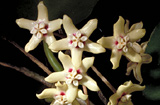 |
Butterflies are attracted to the flowers of Hoya australis, a rainforest climber from eastern Australia.
Select the thumbnail image or plant name for a higher resolution image (19k).
|
 |
The colourful flowers of Brachychiton discolor appeal to humans as well as butterflies!
Select the thumbnail image or plant name for a higher resolution image (29k).
|
As shown in Appendix 1, there are very many butterfly species recorded from Townsville and many of these were first recorded in garden settings. There will probably be additional species added to the list in due course. In 1998 the White Nymph, Mynes geoffroyi, was added when a female arrived in my yard and produced numerous eggs on several food plants (Pipturus argenteus) I had grown. Without the larval food plant this species may never have been noticed (see below).
Appendix 2 lists a number of plants which have been found useful as butterfly larval food plants in Townsville. One interesting thing to notice is the very wide range of plant families which are used by butterflies. Although in different areas the composition of such a list would vary, for most parts of Australia a similar mixture of plants would be useful. In each State or region it would be useful for SGAP members to make contact with local entomologists and put together a comprehensive list of plants for butterfly species in the region as a target for plant growers. Field testing in gardens would then be able to refine a recommended list. One word of caution might be worthwhile. Even if a species may seem unlikely to occur naturally in a garden setting suitable plants might still be usefully provided. In Townsville I have been repeatedly surprised at rainforest species arriving in my garden after I have planted larval food plants. Clearly we often miss what happens in the garden!
Conclusions
Urban landscapes, including private gardens, are capable of supporting a wide range of butterfly species. A combination of native plants for larval food, carefully selected for the particular location, can contribute to the maintenance of local and regional biodiversity of butterflies. As in other continents where we humans have badly disturbed the environment, private efforts in maintaining a regional butterfly fauna may lead to valuable conservation outcomes (see New, 1997 and also Pullin, 1995). Already in Australia we are officially recognising the first few butterfly species which we have rendered endangered due to habitat destruction. Butterfly gardening provides an opportunity to help some species persist in otherwise sterile urban landscapes.
There is scope for increasing the diversity of butterfly food plants used in regional scale plantings, perhaps coordinated to ensure other co-requisites of butterflies are also provided. The artificial construction or reconstruction of complex associations of plants and insects is a very worthwhile challenge for native plant gardeners at all scales. Much remains to be learned in Australia.
NB: since completing this paper, two additional species have now been added to the list, both arriving in my yard in Townsville in late 1998 and early 1999. These were Tellervo zoilus (The Hamadryad) and Pantoporia consimilis (the Orange Aeroplane) respectively. (PSV 30.3.99)
References
- Brewer, Jo 1979 Bringing butterflies to the garden, Horticulture, May.
- Clyne, D. 1990 How to Attract Butterflies to Your Garden, Reed Books, Sydney.
- Collman, Sharon 1983 The butterfly's world: notes of a butterfly gardener, University of Washington Arboretum Bulletin 46(2):16-26
- Coupar, P. and Coupar, M. 1992 Flying Colours, NSW University Press, Kensington.
- Cribb, P. 1982 How to encourage butterflies to live in your garden, Insect Conservation News 6:4-10; (Amateur Entomologists Society, UK)
- Davies, W. 1983 Report of the Brisbane Wildlife Survey. Wildlife Preservation Society of Queensland, Brisbane. 93 pp.
- Hay, R.W. et al. 1994 Bring back the Butterflies: Butterfly Gardening for Western Australians, WA Museum 72 pp.
- New, T. 1997 Butterfly Conservation (2nd edition), Oxford University Press.
- Owen, D.F. 1976 Conservation of butterflies in garden habitats, Environmental Conservation 3/4:285-290.
- Pullin, A.S. (ed) 1995 Ecology and Conservation of Butterflies, Chapman and Hall, London.
- Sankowsky, G. 1982 Attracting Butterflies to Your Garden, Tablelands Branch, Society for Growing Australian Plants, (revised edition published 1987).
- Schneck, M. 1990 Butterflies: How to Identify and Attract Them to Your Garden, Rodale Press, Emmaus, Pennsylvania, 160 pp
- Stokes, D., Stokes, L. and Williams, E. 1991 The Butterfly Book: an Easy Guide to Butterfly Gardening, Identification and Behaviour, Little Brown and Co, Boston, 96 pp.
- Tekulsky, M. 1985 The Butterfly Garden, The Harvard Common Press, 144 pp
- Townsend, K. (ed) 1994 Across the Top, Society for Growing Australian Plants, Townsville.
- Valentine, P.S. 1988 Australian Tropical Butterflies, Frith & Frith Books, Malanda.
- Valentine, P.S. 1993 Urban Butterflies: A Provisional List for Townsville, News Bulletin Entomological Society of Queensland 21(9):160-164.
- Valentine, P.S. 1994 Backyard Butterflies in Northern Queensland: The Late Dry Season Victorian Entomologist 24(2):38-41.
- Valentine, P.S. 1998 The Butterflies of Townsville, Brolga: 28(3):
Xerces Society 1990 Butterfly Gardening, Sierra Club Books, San Francisco, 192 pp.
Appendix 1 - The Butterflies of Townsville
Appendix 2 - Plants for Townsville Butterfly Gardeners
This article was presented to the Society for Growing Australian Plants' Queensland Region Conference, Townsville, 28 June-5 July, 1998.
Peter Valentine is a Senior Lecturer, Tropical Environment Studies & Geography, James Cook University, Townsville Queensland, 4811

[Front Page] [Features] [Departments] [SGAP Home Page] [Subscribe]
Australian Plants online - June 1999
Association of Societies for Growing Australian Plants
|